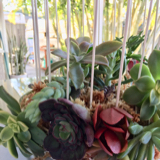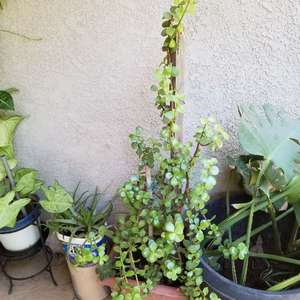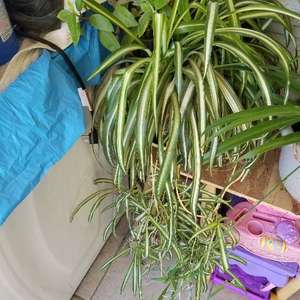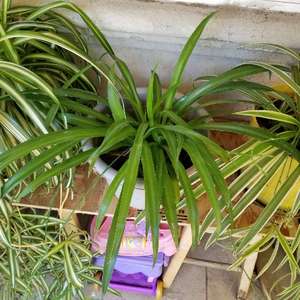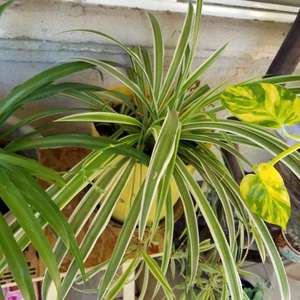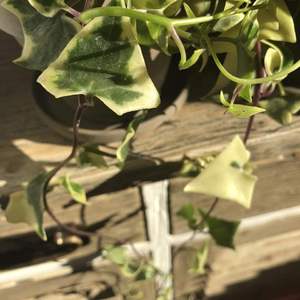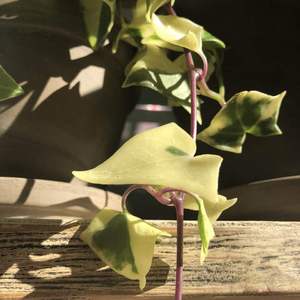文章
Miss Chen
2018年07月10日

Description: This herbaceous plant is a winter or spring annual, producing leafy and flowering stems about 4-18" (10-45 cm.) long. These stems branch primarily near the base of the plant and they are ascending to widely sprawling. Individual stems are whitish green to light reddish green, terete, and woolly-pubescent. Alternate leaves occur along these stems that are ¾-2" (2-5 cm.) long and about one-half as much across; they are broadly oblong in outline, while their structure is deeply bipinnatifid. The ultimate leaf segments are 1.5-5.0 mm. long and about one-third as much across; these segments are oblong-acute in shape. The leaves are pale green and they are covered with short woolly pubescence that becomes more sparse with age. The short petioles are relatively broad, flattened, and whitish green to nearly white; they usually have simple or pinnate lobes along their margins that resemble the leaf segments.
The upper stems terminate in individual flowerheads that span about ¾-1¼" (2-3 cm.) across; these flowerheads have peduncles that are 1½-6" (4-15 cm.) in length. These peduncles are pale green, terete, and woolly-pubescent. Usually, small alternate bracts occur along the peduncles that resemble the leaves. Each daisy-like flowerhead has 10-18 ray florets that surround numerous disk florets; the ray florets are fertile and pistillate, while the disk florets are fertile and perfect. The petaloid rays of the ray florets are white, oblong in shape, and notched at their tips. The tiny corollas of the disk florets are yellow, tubular in shape, and 5-lobed at their apices; these lobes are triangular in shape. Alongside the disk florets, there are chaffy scales about 4 mm. in length. These scales are oblanceolate in shape and their tips are acute; sometimes these tips are awn-like. At the base of each flowerhead, there are 1-2 series of phyllaries (floral bracts) that are broadly oblong in shape. Individual phyllaries have convex central ridges that are light green, wide membranous margins that are white to light brown, and woolly pubescence; the phyllaries become chaffy with age. The foliage of this plant lacks a significant fragrance, although the crushed flowerheads are mildly fragrant (resembling apple-pineapple). The flowerheads are solid, lacking hollow centers. The blooming period usually occurs from late spring to mid-summer, lasting about 1-2 months, although some plants may bloom later in the year.

At maturity, the seedheads are ovoid in shape. The achenes are 1.5-2.5 mm. in length, oblanceoloid in shape, and slightly 4-angled; they are truncate at their apices, where they lack tufts of hair or significant scales. The sides of mature achenes have longitudinal ribs that are readily visible. The achenes are distributed to a limited extent by wind and probably by water at some locations. The root system consists of a shallow much-branched taproot or it is fibrous. Reproduction is by seeds.
Cultivation: The preference is full sun, moist to dry-mesic conditions, and a calcareous soil containing clay-loam, loam, silt, gravel, or sand. Drought tolerance is good. The seeds can remain viable in the ground for 10 years or more (Kay, 1971).
Range & Habitat: Field Chamomile has been found in scattered locations across Illinois (see Distribution Map), but this non-native plant is relatively uncommon within the state. It was introduced into North America from Eurasia, where it is native. In Illinois, habitats consist of fallow fields, roadsides, flood zones along drainage canals and retention ponds, vacant lots and abandoned homestead sites, and waste areas. Highly disturbed areas are preferred.

Faunal Associations: The flowerheads probably attract small bees, various flies (including Syrphid flies), and other insects. Both nectar and pollen are available as floral rewards to such visitors. Insects that feed destructively on Field Chamomile and other Anthemis spp. include Polymerus basalis (Red-Spotted Aster Mirid) and two aphids, Macrosiphoniella tanacetaria and Macrosiphoniella tapuskae. The former aphid is typically found on the flowerheads, peduncles, and upper stems, while the latter aphid is typically found on the lower leaves. The polyphagous caterpillars of a moth, Orthonama obstipata (The Gem), have been reported to feed on mayweeds by Covell (1984/2005). Field Chamomile belongs to the group of plants that are commonly referred to as mayweeds in Europe. The foliage of Field Chamomile is probably browsed sparingly by mammalian herbivores, while Canada Geese seem to avoid it. Because the seeds can pass through the gastrointestinal tracts of both cattle and pigeons and remain viable (Kay, 1971), these animals may spread them to new areas. It is also possible for the seeds to cling to the bottoms of the muddy shoes of people and the muddy hoofs of animals, by which means they can spread to new areas.
Photographic Location: Along a drainage canal and retention pond area in Champaign, Illinois.

Comments: Field Chamomile (Anthemis arvensis) is one of the plants that are commonly referred to as mayweeds. Examples of these species include Anthemis cotula (Dog Fennel), Chamaemelum nobile (Roman Chamomile), Matricaria recutita (German Chamomile), and Tripleurospermum perforatum (Scentless Chamomile). As a group, they are difficult to distinguish from each other. All of these species have daisy-like flowerheads that resemble those of Leucanthemum vulgare (Ox-Eye Daisy), but their foliage is deeply dissected (typically bipinnatifid). Field Chamomile can be distinguished from other mayweeds by its flat leaf-segments (rather than terete leaf-segments), by the presence and shape of the chaffy scales in its flowerheads, by the woolly pubescence of its foliage, and by the appearance of its achenes. The foliage of Field Chamomile lacks the pleasant fragrance of Roman Chamomile, nor does it possess the unpleasant odor of Dog Fennel. Similar to German Chamomile, the crushed flowerheads of Field Chamomile are mildly fragrant, but it has completely solid flowerheads, whereas the flowerheads of German Chamomile have interiors that are partly hollow.
The upper stems terminate in individual flowerheads that span about ¾-1¼" (2-3 cm.) across; these flowerheads have peduncles that are 1½-6" (4-15 cm.) in length. These peduncles are pale green, terete, and woolly-pubescent. Usually, small alternate bracts occur along the peduncles that resemble the leaves. Each daisy-like flowerhead has 10-18 ray florets that surround numerous disk florets; the ray florets are fertile and pistillate, while the disk florets are fertile and perfect. The petaloid rays of the ray florets are white, oblong in shape, and notched at their tips. The tiny corollas of the disk florets are yellow, tubular in shape, and 5-lobed at their apices; these lobes are triangular in shape. Alongside the disk florets, there are chaffy scales about 4 mm. in length. These scales are oblanceolate in shape and their tips are acute; sometimes these tips are awn-like. At the base of each flowerhead, there are 1-2 series of phyllaries (floral bracts) that are broadly oblong in shape. Individual phyllaries have convex central ridges that are light green, wide membranous margins that are white to light brown, and woolly pubescence; the phyllaries become chaffy with age. The foliage of this plant lacks a significant fragrance, although the crushed flowerheads are mildly fragrant (resembling apple-pineapple). The flowerheads are solid, lacking hollow centers. The blooming period usually occurs from late spring to mid-summer, lasting about 1-2 months, although some plants may bloom later in the year.

At maturity, the seedheads are ovoid in shape. The achenes are 1.5-2.5 mm. in length, oblanceoloid in shape, and slightly 4-angled; they are truncate at their apices, where they lack tufts of hair or significant scales. The sides of mature achenes have longitudinal ribs that are readily visible. The achenes are distributed to a limited extent by wind and probably by water at some locations. The root system consists of a shallow much-branched taproot or it is fibrous. Reproduction is by seeds.
Cultivation: The preference is full sun, moist to dry-mesic conditions, and a calcareous soil containing clay-loam, loam, silt, gravel, or sand. Drought tolerance is good. The seeds can remain viable in the ground for 10 years or more (Kay, 1971).
Range & Habitat: Field Chamomile has been found in scattered locations across Illinois (see Distribution Map), but this non-native plant is relatively uncommon within the state. It was introduced into North America from Eurasia, where it is native. In Illinois, habitats consist of fallow fields, roadsides, flood zones along drainage canals and retention ponds, vacant lots and abandoned homestead sites, and waste areas. Highly disturbed areas are preferred.

Faunal Associations: The flowerheads probably attract small bees, various flies (including Syrphid flies), and other insects. Both nectar and pollen are available as floral rewards to such visitors. Insects that feed destructively on Field Chamomile and other Anthemis spp. include Polymerus basalis (Red-Spotted Aster Mirid) and two aphids, Macrosiphoniella tanacetaria and Macrosiphoniella tapuskae. The former aphid is typically found on the flowerheads, peduncles, and upper stems, while the latter aphid is typically found on the lower leaves. The polyphagous caterpillars of a moth, Orthonama obstipata (The Gem), have been reported to feed on mayweeds by Covell (1984/2005). Field Chamomile belongs to the group of plants that are commonly referred to as mayweeds in Europe. The foliage of Field Chamomile is probably browsed sparingly by mammalian herbivores, while Canada Geese seem to avoid it. Because the seeds can pass through the gastrointestinal tracts of both cattle and pigeons and remain viable (Kay, 1971), these animals may spread them to new areas. It is also possible for the seeds to cling to the bottoms of the muddy shoes of people and the muddy hoofs of animals, by which means they can spread to new areas.
Photographic Location: Along a drainage canal and retention pond area in Champaign, Illinois.

Comments: Field Chamomile (Anthemis arvensis) is one of the plants that are commonly referred to as mayweeds. Examples of these species include Anthemis cotula (Dog Fennel), Chamaemelum nobile (Roman Chamomile), Matricaria recutita (German Chamomile), and Tripleurospermum perforatum (Scentless Chamomile). As a group, they are difficult to distinguish from each other. All of these species have daisy-like flowerheads that resemble those of Leucanthemum vulgare (Ox-Eye Daisy), but their foliage is deeply dissected (typically bipinnatifid). Field Chamomile can be distinguished from other mayweeds by its flat leaf-segments (rather than terete leaf-segments), by the presence and shape of the chaffy scales in its flowerheads, by the woolly pubescence of its foliage, and by the appearance of its achenes. The foliage of Field Chamomile lacks the pleasant fragrance of Roman Chamomile, nor does it possess the unpleasant odor of Dog Fennel. Similar to German Chamomile, the crushed flowerheads of Field Chamomile are mildly fragrant, but it has completely solid flowerheads, whereas the flowerheads of German Chamomile have interiors that are partly hollow.
0
0
文章
Miss Chen
2018年07月10日

Description: This herbaceous plant is a winter or spring annual that forms a low rosette of several basal leaves up to 4 cm. (1½") across. Individual basal leaves are 0.5–2 cm. (¼–¾") long and about one-third to one-half as much across; they are elliptic to broadly elliptic in shape, bluntly dentate toward their tips, and sessile. The leaf surface is medium green to reddish green (rarely red); its upper surface has sparse minute pubescence, while its lower surface is glabrous. Each rosette of basal leaves develops 1–15 flowering stalks that are 2.5 cm. (1") to 7.5 cm. (3") tall. These stalks are light green, reddish green, or red; they are short-pubescent, terete, and either erect or arching upward. The flowering stalks terminate in either solitary flowers or umbels of flowers (usually the latter); there are 2–10 flowers per umbel. Sometimes 1–2 secondary stalks will originate from an umbel of flowers to produce secondary umbels of flowers, making an inflorescence a partially compound umbel of flowers.
The secondary flowering stalks are similar to the primary flowering stalks, except they are usually shorter. The secondary umbels of flowers are similar to the primary umbels of flowers, except they tend to have fewer flowers. The pedicels of the flowers (or seed capsules) are 3–25 mm. (1/8–1") in length and erect to upwardly arching. Compared to the flowering stalks (peduncles), the pedicels are shorter and more slender, although they become longer as the seed capsules develop. Individual flowers are about 2 mm. across and 4 mm. long; each flower has a green calyx with 5 erect teeth, a white tubular corolla with 5 ascending lobes, 5 inserted stamens with short filaments, and a light green ovary with a single short style. The calyx is 5-angular from 5 ridges and it has sparse minute pubescence. The teeth of the calyx extend above the lobes of the corolla. Individual lobes of the corolla are lanceolate in shape. The teeth of the calyx are narrowly deltate to deltate in shape and a little shorter than the angular calyx-tube.

At the base of each umbel (or secondary umbel) of flowers, there are 2 or more leafy bracts that resemble the basal leaves, except they are smaller in size (less than 0.5 cm. or ¼" in length) and they lack teeth; sometimes they form a small rosette. The blooming period occurs from from early to late spring, lasting about 1 month. The flowers are inconspicuous. Afterwards, they are replaced by small seed capsules. These capsules are about 3 mm. long and ovoid in shape; each capsule eventually divides into 5 sections to release several seeds. These seeds are small enough to be blown about by the wind. Mature seeds are about 1 mm. long, 0.75 mm. across, 3-angled, and dark brown to black; the seed surface has a network of minute ridges and pits. The root system consists of a slender taproot. This plant reproduces by reseeding itself. It dies down no later than mid-summer.
Cultivation: The preference is full to partial sun, mesic to dry conditions, and a barren soil containing sand, gravel, clay, or rocky debris. Most growth and development occurs during the spring, which happens very quickly.

Range & Habitat: Western Rock Jasmine (Androsace occidentalis) is a native plant in Illinois, where it occurs occasionally in western and northern Illinois, while in the rest of the state it is uncommon or absent (see Distribution Map). This plant is more common in drier areas to the west of Illinois. In Indiana, Ohio, and Michigan, this plant is rare and state-listed as 'threatened' or 'endangered.' Habitats include gravel hill prairies, upland sand prairies, upland dolomite prairies, gravelly or sandy areas along railroads, roadsides, pastures, fallow fields, and waste ground. In Illinois, Western Rock Jasmine occurs in both higher quality natural areas and disturbed areas on exposed ground soil where it is dry and sunny.
Faunal Associations: This plant becomes more common in pastures that are moderately to heavily grazed by cattle as this reduces competition from taller and more aggressive plants (Patton & Nyren, 2015).

Photographic Location: Found on waste ground along an alley way in Urbana, Illinois. This dumped waste ground contained broken bricks and pieces of concrete.
Comments: This tiny plant has inconspicuous flowers and it is easily overlooked. When the stalks with umbels of flowers are produced, it fairly easy to identify, however. Western Rock Jasmine (Androsace occidentalis) is the only species of its genus that has been found in Illinois. Further to the west, however, there are several Rock Jasmine species (Androsace spp.). These more western species tend to be less weedy in appearance and they have showier flowers. Other common names for Androsace occidentalis are Western Rock Primrose and Western Fairy Candelabra. Sometimes this plant is simply referred to as Rock Jasmine, Rock Primrose, or Fairy Candelabra.
The secondary flowering stalks are similar to the primary flowering stalks, except they are usually shorter. The secondary umbels of flowers are similar to the primary umbels of flowers, except they tend to have fewer flowers. The pedicels of the flowers (or seed capsules) are 3–25 mm. (1/8–1") in length and erect to upwardly arching. Compared to the flowering stalks (peduncles), the pedicels are shorter and more slender, although they become longer as the seed capsules develop. Individual flowers are about 2 mm. across and 4 mm. long; each flower has a green calyx with 5 erect teeth, a white tubular corolla with 5 ascending lobes, 5 inserted stamens with short filaments, and a light green ovary with a single short style. The calyx is 5-angular from 5 ridges and it has sparse minute pubescence. The teeth of the calyx extend above the lobes of the corolla. Individual lobes of the corolla are lanceolate in shape. The teeth of the calyx are narrowly deltate to deltate in shape and a little shorter than the angular calyx-tube.

At the base of each umbel (or secondary umbel) of flowers, there are 2 or more leafy bracts that resemble the basal leaves, except they are smaller in size (less than 0.5 cm. or ¼" in length) and they lack teeth; sometimes they form a small rosette. The blooming period occurs from from early to late spring, lasting about 1 month. The flowers are inconspicuous. Afterwards, they are replaced by small seed capsules. These capsules are about 3 mm. long and ovoid in shape; each capsule eventually divides into 5 sections to release several seeds. These seeds are small enough to be blown about by the wind. Mature seeds are about 1 mm. long, 0.75 mm. across, 3-angled, and dark brown to black; the seed surface has a network of minute ridges and pits. The root system consists of a slender taproot. This plant reproduces by reseeding itself. It dies down no later than mid-summer.
Cultivation: The preference is full to partial sun, mesic to dry conditions, and a barren soil containing sand, gravel, clay, or rocky debris. Most growth and development occurs during the spring, which happens very quickly.

Range & Habitat: Western Rock Jasmine (Androsace occidentalis) is a native plant in Illinois, where it occurs occasionally in western and northern Illinois, while in the rest of the state it is uncommon or absent (see Distribution Map). This plant is more common in drier areas to the west of Illinois. In Indiana, Ohio, and Michigan, this plant is rare and state-listed as 'threatened' or 'endangered.' Habitats include gravel hill prairies, upland sand prairies, upland dolomite prairies, gravelly or sandy areas along railroads, roadsides, pastures, fallow fields, and waste ground. In Illinois, Western Rock Jasmine occurs in both higher quality natural areas and disturbed areas on exposed ground soil where it is dry and sunny.
Faunal Associations: This plant becomes more common in pastures that are moderately to heavily grazed by cattle as this reduces competition from taller and more aggressive plants (Patton & Nyren, 2015).

Photographic Location: Found on waste ground along an alley way in Urbana, Illinois. This dumped waste ground contained broken bricks and pieces of concrete.
Comments: This tiny plant has inconspicuous flowers and it is easily overlooked. When the stalks with umbels of flowers are produced, it fairly easy to identify, however. Western Rock Jasmine (Androsace occidentalis) is the only species of its genus that has been found in Illinois. Further to the west, however, there are several Rock Jasmine species (Androsace spp.). These more western species tend to be less weedy in appearance and they have showier flowers. Other common names for Androsace occidentalis are Western Rock Primrose and Western Fairy Candelabra. Sometimes this plant is simply referred to as Rock Jasmine, Rock Primrose, or Fairy Candelabra.
0
0
文章
Miss Chen
2018年07月10日


06Growing Jade Plants
There are several species that are sold under the generic name jade plant. They are all Crassula species. Also called money plants or dollar plants, these are thought to bring good luck.

07Growing Kalanchoe
Although there are many kinds of kalanchoe, the K. blossfeldiana is the most popular. Its sprays of bright flowers make it one of the most desired houseplants around the world.

08Growing Pencil Cactus (Euphorbia tirucalli)
The pencil cactus is actually another Euphorbia species. These plants are grown for their strange, even slightly bizarre foliage.

09Growing Sempervivum
Sometimes called hen and chick plants, Sempervivum succulents are some of the hardiest: hot or cold, light or shade, they can thrive. With good care, these are magnificent accent plants.

10Creating a Succulent Dish Garden
Follow these simple, step-by-step instructions to creating a beautiful dish garden using succulents.
2
1
Pommy Mommy
2018年07月10日

I planted my HUNDREDTH potted plant today! It's a good thing I'm moving because I don't think I could fit many more pott33s. The new house sits on nearly an acre! I have to move all 100 pots AND the trampoline frame (that's what all those hanging basket are hanging from)

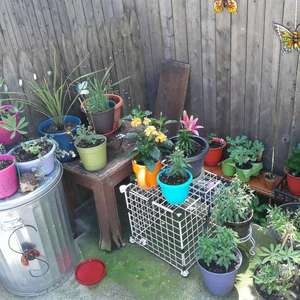




2
0
文章
Miss Chen
2018年07月09日

Description: This plant is a summer annual about 1-3' tall that is either sparingly branched or unbranched. The central stem is stout, round, light green, and more or less covered with white hairs; it also has fine longitudinal veins that are white. The alternate leaves are up to 6" long and 4" across (excluding the petioles), becoming smaller in the upper half of the central stem. They are cordate-ovate or elliptic and smooth or slightly undulate along the margins. The base of each leaf is rounded or wedge-shaped, while its tip is rounded and blunt. The lower surface of each leaf is usually pubescent, while the upper surface is less pubescent or hairless.
The central stem terminates in a stout panicle of spikes with whitish green flowers. This terminal inflorescence is up to 6" long (rarely longer in large plants). There are also shorter axilllary panicles of flowering spikes or simple spikes that develop from the axils of the middle to upper leaves. The flowering spikes are bristly in appearance from the crowded flowers and pointed bracts. Rough Pigweed is usually monoecious with separate pistillate (female) and staminate (male) flowers on the same plant. The pistillate flowers have 5 pale white sepals, an ovary with 3 styles, and no petals. The staminate flowers have 5 pale white sepals, 5 stamens, and no petals. The sepals are oblong and about 3 mm. in length; their tips are either short and pointed or flattened. At the base of each flower, there are one or more green bracts about 3-6 mm. long. These bracts have long pointed tips. The blooming period occurs from late summer to early fall and lasts about 1-2 months. Cross-pollination of the flowers is by wind. Each pistillate flower develops a single seed in a membranous bladder (utricle). This utricle splits up to release the seed. Each small seed is dark brown or black, flattened, and circular; it has a smooth and shiny surface. The root system consists of a short stout taproot that is usually tinted red. This plant spreads by reseeding itself.

Cultivation: This plant is typically found in full sun, mesic to dry conditions, and a soil containing loam, clay-loam, or gravelly material. Its size can vary significantly according to moisture levels and the fertility of the soil. The seeds can remain viable in the soil for 30 years or more.
Range & Habitat: The non-native Rough Pigweed is a common plant that occurs in most counties of Illinois (see Distribution Map). It is originally from South America. Habitats include degraded upland prairies, cropland, fallow fields, farm lots, gardens, gravelly areas along roads and railroads, sunny areas along the foundations of buildings, and waste areas. Highly disturbed areas are preferred.

Faunal Associations: Insects rarely visit the wind-pollinated flowers. The caterpillars of the skipper Pholisora catullus (Common Sootywing) feed on the foliage, as do the caterpillars of several moths, including Holomelina aurantiaca (Orange Holomelina), Hymenia perspectalis (Spotted Beet Webworm Moth), Spilosoma congrua (Agreeable Tiger Moth), and Spoladea recurvalis (Hawaiian Beet Webworm Moth). Sometimes Disonycha spp. (Flea Beetles) chew little holes in the leaves. The seeds of pigweeds are very popular with granivorus birds as a source of food during the fall and winter (see Bird Table). Pigs and cattle eat pigweeds readily, although the foliage can cause bloating and other symptoms of nitrate poisoning if an excessive amount of the foliage is eatened. Deer and rabbits eat pigweeds to a limited extent.
Photographic Location: Along the pebbly foundation of the webmaster's apartment building in Urbana, Illinois.

Comments: Rough Pigweed is another weedy member of the Amaranth family, although its seeds are an important source of food to birds. It is quite similar in appearance to another common weed, Amaranthus hybridus (Slender Amaranth), and prefers similar habitats (perhaps those that are slightly drier). Rough Pigweed tends to be shorter and stouter in its growth habit than Slender Pigweed. The flowering spikes of Rough Pigweed are usually more stout and bristly than those of Slender Pigweed; the flowering spikes of Rough Pigweed are whitish green while in bloom, while the flowering spikes of Slender Pigweed are more green (because its sepals are less conspicuous). Using a 10x hand lense, it is possible to observe that the sepals of Rough Pigweed often have flattened tips, while the sepals of Slender Pigweed are more pointed at their tips. Furthermore, the floral bracts of Rough Pigweed are up to 6 mm. in length, while those of Slender Pigweed are up to 4 mm. in length. Red forms of Rough Pigweed apparently don't occur; reddish pigweeds are usually Slender Pigweed, or less often a cultivated Amaranth that has escaped from gardens.
The central stem terminates in a stout panicle of spikes with whitish green flowers. This terminal inflorescence is up to 6" long (rarely longer in large plants). There are also shorter axilllary panicles of flowering spikes or simple spikes that develop from the axils of the middle to upper leaves. The flowering spikes are bristly in appearance from the crowded flowers and pointed bracts. Rough Pigweed is usually monoecious with separate pistillate (female) and staminate (male) flowers on the same plant. The pistillate flowers have 5 pale white sepals, an ovary with 3 styles, and no petals. The staminate flowers have 5 pale white sepals, 5 stamens, and no petals. The sepals are oblong and about 3 mm. in length; their tips are either short and pointed or flattened. At the base of each flower, there are one or more green bracts about 3-6 mm. long. These bracts have long pointed tips. The blooming period occurs from late summer to early fall and lasts about 1-2 months. Cross-pollination of the flowers is by wind. Each pistillate flower develops a single seed in a membranous bladder (utricle). This utricle splits up to release the seed. Each small seed is dark brown or black, flattened, and circular; it has a smooth and shiny surface. The root system consists of a short stout taproot that is usually tinted red. This plant spreads by reseeding itself.

Cultivation: This plant is typically found in full sun, mesic to dry conditions, and a soil containing loam, clay-loam, or gravelly material. Its size can vary significantly according to moisture levels and the fertility of the soil. The seeds can remain viable in the soil for 30 years or more.
Range & Habitat: The non-native Rough Pigweed is a common plant that occurs in most counties of Illinois (see Distribution Map). It is originally from South America. Habitats include degraded upland prairies, cropland, fallow fields, farm lots, gardens, gravelly areas along roads and railroads, sunny areas along the foundations of buildings, and waste areas. Highly disturbed areas are preferred.

Faunal Associations: Insects rarely visit the wind-pollinated flowers. The caterpillars of the skipper Pholisora catullus (Common Sootywing) feed on the foliage, as do the caterpillars of several moths, including Holomelina aurantiaca (Orange Holomelina), Hymenia perspectalis (Spotted Beet Webworm Moth), Spilosoma congrua (Agreeable Tiger Moth), and Spoladea recurvalis (Hawaiian Beet Webworm Moth). Sometimes Disonycha spp. (Flea Beetles) chew little holes in the leaves. The seeds of pigweeds are very popular with granivorus birds as a source of food during the fall and winter (see Bird Table). Pigs and cattle eat pigweeds readily, although the foliage can cause bloating and other symptoms of nitrate poisoning if an excessive amount of the foliage is eatened. Deer and rabbits eat pigweeds to a limited extent.
Photographic Location: Along the pebbly foundation of the webmaster's apartment building in Urbana, Illinois.

Comments: Rough Pigweed is another weedy member of the Amaranth family, although its seeds are an important source of food to birds. It is quite similar in appearance to another common weed, Amaranthus hybridus (Slender Amaranth), and prefers similar habitats (perhaps those that are slightly drier). Rough Pigweed tends to be shorter and stouter in its growth habit than Slender Pigweed. The flowering spikes of Rough Pigweed are usually more stout and bristly than those of Slender Pigweed; the flowering spikes of Rough Pigweed are whitish green while in bloom, while the flowering spikes of Slender Pigweed are more green (because its sepals are less conspicuous). Using a 10x hand lense, it is possible to observe that the sepals of Rough Pigweed often have flattened tips, while the sepals of Slender Pigweed are more pointed at their tips. Furthermore, the floral bracts of Rough Pigweed are up to 6 mm. in length, while those of Slender Pigweed are up to 4 mm. in length. Red forms of Rough Pigweed apparently don't occur; reddish pigweeds are usually Slender Pigweed, or less often a cultivated Amaranth that has escaped from gardens.
0
0
文章
Miss Chen
2018年07月09日

Description: This herbaceous perennial plant consists of a rosette of 2-8 basal leaves and a single flowering stalk. The glabrous basal leaves are up to 12" long and ¼" across; they are linear with parallel veins, flattened and solid in cross-section, rather than round and hollow. The basal leaves are rather floppy and often curve downward near the middle, rather than remaining erect. They are green or greyish green, but turn yellow and wither away after the flowers bloom. The flowering stalk is up to 18" long and stiffly erect; it is round or terete and solid in cross-section. This stalk is devoid of cauline leaves and terminates in an umbel of 15-40 flowers that spans about 2" across. Each flower is about ¼" across and consists of 6 white tepals, 6 stamens with conspicuous anthers, and a single slender style. Each tepal may have a line along the middle of its outer/lower surface that is light green, light purple, or light brown. The white filaments of the stamens are narrowly triangular as they become more narrow at their tips where the anthers occur. Each flower has a slender pedicel up to 1" long. At the base of the umbel, there are often 1-3 membranous bracts that originally enclosed the buds of the flowers.
The blooming period occurs from late summer to early fall and lasts about 1 month. The flowers are fragrant. Each flower is replaced by a green seed capsule that is 3-celled and has 3 rounded lobes. Each capsule contains several seeds that are small, black, and shiny. Unlike some Allium spp., no aerial bulbets are produced. The root system consists of an elongated bulb with fibrous roots at the bottom. This plant reproduces by its seeds and vegetative offsets. It often forms clumps of plants.
Cultivation: The preference is full or partial sun, moist to dry conditions, and a rich loamy soil. This plant can spread aggressively by either its seeds or vegetative offsets. Clumps of plants are easily divided and the divided clumps can be planted in new locations. This plant is winter hardy in all areas of Illinois.

Range & Habitat: According to official records, Garlic Chives has not naturalized in Illinois, even though it is often cultivated as a garden plant. This is surprising, considering its aggressive nature. However, the webmaster has observed clumps of naturalized plants that were growing in 3 different locations in the Champaign-Urbana area in Champaign County, Illinois (see Distribution Map). Garlic Chives has naturalized in parts of Wisconsin, Iowa, and Nebraska, and it seems likely that this plant has naturalized in other counties of Illinois as well. It is native to China and parts of SE Asia. So far, habitats in Illinois include a degraded meadow in a wooded area, the bank of a drainage ditch, and the edge of a yard along a sidewalk. Several clumps of Garlic Chives have persisted in the meadow for several years.
Faunal Associations: The nectar of the flowers attracts bees, wasps, flies, butterflies, and skippers. Some of the bees probably collect pollen as well. The foliage has a garlic scent, which is repugnant to many mammalian herbivores. However, young leaves are edible to humans in limited amounts.

Photographic Location: Along a sidewalk in Urbana, Illinois.
Comments: Garlic Chives is often grown in gardens because of its attractive flowers and the culinary properties of the leaves. This plant is fairly easy to identify because it blooms later than other native or naturalized Allium spp., usually in late summer or early fall. The basal leaves of Garlic Chives resemble those of the native Allium cernuum (Nodding Onion), but the latter species has umbels that hang downward and it blooms during mid-summer. The flowering umbels of Garlic Chives resemble those of the native Allium stellatum (Cliff Onion), but the latter has basal leaves that are more narrow and upright. Other Allium spp. differ from Garlic Chives because they bloom earlier in the year, or they produce aerial bulbets, or they have basal leaves that are round and hollow in cross-section.
The blooming period occurs from late summer to early fall and lasts about 1 month. The flowers are fragrant. Each flower is replaced by a green seed capsule that is 3-celled and has 3 rounded lobes. Each capsule contains several seeds that are small, black, and shiny. Unlike some Allium spp., no aerial bulbets are produced. The root system consists of an elongated bulb with fibrous roots at the bottom. This plant reproduces by its seeds and vegetative offsets. It often forms clumps of plants.
Cultivation: The preference is full or partial sun, moist to dry conditions, and a rich loamy soil. This plant can spread aggressively by either its seeds or vegetative offsets. Clumps of plants are easily divided and the divided clumps can be planted in new locations. This plant is winter hardy in all areas of Illinois.

Range & Habitat: According to official records, Garlic Chives has not naturalized in Illinois, even though it is often cultivated as a garden plant. This is surprising, considering its aggressive nature. However, the webmaster has observed clumps of naturalized plants that were growing in 3 different locations in the Champaign-Urbana area in Champaign County, Illinois (see Distribution Map). Garlic Chives has naturalized in parts of Wisconsin, Iowa, and Nebraska, and it seems likely that this plant has naturalized in other counties of Illinois as well. It is native to China and parts of SE Asia. So far, habitats in Illinois include a degraded meadow in a wooded area, the bank of a drainage ditch, and the edge of a yard along a sidewalk. Several clumps of Garlic Chives have persisted in the meadow for several years.
Faunal Associations: The nectar of the flowers attracts bees, wasps, flies, butterflies, and skippers. Some of the bees probably collect pollen as well. The foliage has a garlic scent, which is repugnant to many mammalian herbivores. However, young leaves are edible to humans in limited amounts.

Photographic Location: Along a sidewalk in Urbana, Illinois.
Comments: Garlic Chives is often grown in gardens because of its attractive flowers and the culinary properties of the leaves. This plant is fairly easy to identify because it blooms later than other native or naturalized Allium spp., usually in late summer or early fall. The basal leaves of Garlic Chives resemble those of the native Allium cernuum (Nodding Onion), but the latter species has umbels that hang downward and it blooms during mid-summer. The flowering umbels of Garlic Chives resemble those of the native Allium stellatum (Cliff Onion), but the latter has basal leaves that are more narrow and upright. Other Allium spp. differ from Garlic Chives because they bloom earlier in the year, or they produce aerial bulbets, or they have basal leaves that are round and hollow in cross-section.
0
0
文章
Miss Chen
2018年07月09日

Description: This herbaceous perennial plant is 6-20" tall, consisting of a dense tuft of basal leaves from tightly clustered bulbs. The basal leaves are erect, ascending, or arching-spreading; they are medium green, filiform, terete, hollow, glabrous, and sometimes glaucous. One or more flowering stalks develop from within the basal leaves. These stalks are more stiffly erect than the leaves; they are 8-20" long, medium green, filiform, terete, and glabrous. Usually, the stalks are leafless, although on rare occasions 1-2 cauline leaves may develop from an individual stalk. At the apex of each stalk, there is a crowded umbel of 30-50 flowers that spans about 1–1½" across; this umbel is held erect and it is globoid to subgloboid (globoid, but slightly flattened) in shape. Initially, the umbel is enclosed by a pair of membranous spathes with a sheath-like appearance, but the latter shrivel away when the flowers begin to bloom. Each flower is up to 2/3" (15 mm.) long, consisting of 6 pink or lavender tepals, 6 stamens, and a pistil with a single white style. The filaments of the stamens are white, while their anthers are variably colored. The tepals are narrowly elliptic in shape and strongly ascending; they often have fine lines of purple where their midribs occur. The style has a knobby tip. At the bases of these flowers, there are short pedicels up to ¼" long; these pedicels are largely hidden by the flowers when the latter are in bloom. Both the foliage and flowers have a mild onion-like aroma. The blooming period occurs from late spring to early summer, lasting about 3-4 weeks. Afterwards, individual flowers are replaced by 3-valved seed capsules (3-4 mm. across) that split open to release their seeds. These seeds are 2–2.5 mm. (less than 1/8") in length with a 3-angled ellipsoid shape; 2 sides of each seed are flat, while the remaining side is curved. In addition, the seeds are black, somewhat wrinkled, and glabrous. The root system consists of slender bulbs that are ellipsoid in shape and up to ¾" (20 mm.) in length; these bulbs have fibrous roots underneath. The outermost layers of the bulbs are brown and membranous. Clonal offshoots are created by the formation of new bulbs in the ground. This plant also reproduces by reseeding itself. The leaves die down during the winter.
Cultivation: The preference is full or partial sun, moist to mesic conditions, and a fertile loamy soil. Chives is winter-hardy and easy to cultivate.
Range & Habitat: As a wild plant, Chives has naturalized in only a few counties of Illinois (see Distribution Map), where it is uncommon. While it is native to boreal areas of both Eurasia and North America, Chives was introduced into Illinois as a culinary herb. It is still commonly cultivated in gardens, from where this plant occasionally escapes. Habitats include grassy areas along railroads and roadsides, areas that are adjacent to gardens, weedy meadows, banks of streams, and waste areas. Habitats with a history of disturbance are preferred. Chives is less aggressive than either Allium vineale (Field Garlic) and Allium canadense (Wild Garlic).
Faunal Association: The nectar and pollen of the flowers attract small bees and flower flies primarily. Some insect species are known to feed destructively on Chives (Allium schoenoprasum) and other Allium spp. Insects that feed on the foliage and/or flowers include Thrips tabaci (Onion Thrips), Myzus ascalonicus (Shallot Aphid), Neotoxoptera formosa (Onion Aphid), Lindbergocapsus allii (Onion Plant Bug), and Lindbergocapsus ainsliei; see Marshall (2006), Blackman & Eastop (2013), Knight (1941), and Henry (1982). The larvae of several insects also feed on the bulbs of these plants, including Strigoderma arbicola (False Japanese Beetle), Delia antiqua (Onion Maggot), Tritoxa flexa (Black Onion Fly), Eumerus strigatus (Onion Bulb Fly), and Eumerus tuberculatus (Lesser Onion Bulb Fly). Mammalian herbivores usually avoid consumption of the foliage of Chives and other Allium spp., although it is occasionally consumed by White-tailed Deer and domesticated cattle (Sotala & Kirkpatrick, 1973; Georgia, 1913), especially during the spring when little else is available. When dairy cattle consume these plants, this taints the flavor of milk that they produce.
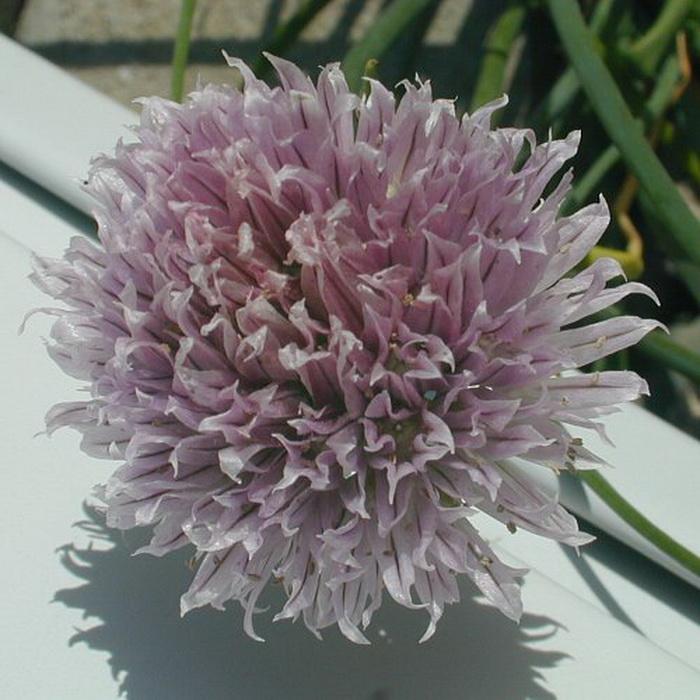
Photographic Location: Along a sidewalk at the webmaster's apartment complex. This plant was established from seed that had blown across the sidewalk from a neighboring pot of herbs.
Comments: The chopped leaves of Chives has a mild onion flavor that can be used to season various dishes and sauces, including salads and sour cream. The umbels of flowers are also edible if they are picked while they are still young; like the leaves, they have an onion flavor. This plant is rich a source of antioxidants, especially the leaves (Stajner et al., 2004). It also contains significant amounts of Vitamin A (as beta-carotene), folic acid, Vitamin C, Vitamin K, protein, and other nutrients. Chives (Allium schoenoprasum) is fairly easy to distinguish from other Allium spp. cause of its dense umbels of flowers and dense tufts of very narrow leaves. The umbels of other Allium spp. are typically more loose and there are conspicuous gaps between their flowers. The basal leaves of other Allium spp. are either solid and flattened or they are more terete and hollow. If they are the latter, then they are somewhat broader in circumference at their bases than the leaves of chives. Chives doesn't produce aerial bulblets, whereas Allium vineale (Field Garlic), Allium canadense (Wild Garlic), and some cultivated Allium spp. almost always do. Two varieties of Chives are sometimes described: the typical variety and var. sibiricum. The latter tends to be a taller and more robust plant, otherwise these two varieties are very similar to each other and they have a tendency to intergrade.
Cultivation: The preference is full or partial sun, moist to mesic conditions, and a fertile loamy soil. Chives is winter-hardy and easy to cultivate.
Range & Habitat: As a wild plant, Chives has naturalized in only a few counties of Illinois (see Distribution Map), where it is uncommon. While it is native to boreal areas of both Eurasia and North America, Chives was introduced into Illinois as a culinary herb. It is still commonly cultivated in gardens, from where this plant occasionally escapes. Habitats include grassy areas along railroads and roadsides, areas that are adjacent to gardens, weedy meadows, banks of streams, and waste areas. Habitats with a history of disturbance are preferred. Chives is less aggressive than either Allium vineale (Field Garlic) and Allium canadense (Wild Garlic).
Faunal Association: The nectar and pollen of the flowers attract small bees and flower flies primarily. Some insect species are known to feed destructively on Chives (Allium schoenoprasum) and other Allium spp. Insects that feed on the foliage and/or flowers include Thrips tabaci (Onion Thrips), Myzus ascalonicus (Shallot Aphid), Neotoxoptera formosa (Onion Aphid), Lindbergocapsus allii (Onion Plant Bug), and Lindbergocapsus ainsliei; see Marshall (2006), Blackman & Eastop (2013), Knight (1941), and Henry (1982). The larvae of several insects also feed on the bulbs of these plants, including Strigoderma arbicola (False Japanese Beetle), Delia antiqua (Onion Maggot), Tritoxa flexa (Black Onion Fly), Eumerus strigatus (Onion Bulb Fly), and Eumerus tuberculatus (Lesser Onion Bulb Fly). Mammalian herbivores usually avoid consumption of the foliage of Chives and other Allium spp., although it is occasionally consumed by White-tailed Deer and domesticated cattle (Sotala & Kirkpatrick, 1973; Georgia, 1913), especially during the spring when little else is available. When dairy cattle consume these plants, this taints the flavor of milk that they produce.

Photographic Location: Along a sidewalk at the webmaster's apartment complex. This plant was established from seed that had blown across the sidewalk from a neighboring pot of herbs.
Comments: The chopped leaves of Chives has a mild onion flavor that can be used to season various dishes and sauces, including salads and sour cream. The umbels of flowers are also edible if they are picked while they are still young; like the leaves, they have an onion flavor. This plant is rich a source of antioxidants, especially the leaves (Stajner et al., 2004). It also contains significant amounts of Vitamin A (as beta-carotene), folic acid, Vitamin C, Vitamin K, protein, and other nutrients. Chives (Allium schoenoprasum) is fairly easy to distinguish from other Allium spp. cause of its dense umbels of flowers and dense tufts of very narrow leaves. The umbels of other Allium spp. are typically more loose and there are conspicuous gaps between their flowers. The basal leaves of other Allium spp. are either solid and flattened or they are more terete and hollow. If they are the latter, then they are somewhat broader in circumference at their bases than the leaves of chives. Chives doesn't produce aerial bulblets, whereas Allium vineale (Field Garlic), Allium canadense (Wild Garlic), and some cultivated Allium spp. almost always do. Two varieties of Chives are sometimes described: the typical variety and var. sibiricum. The latter tends to be a taller and more robust plant, otherwise these two varieties are very similar to each other and they have a tendency to intergrade.
0
0
文章
Miss Chen
2018年07月09日

Description: This plant is a biennial. During the 1st year it consists of a small rosette of leaves, while during the 2nd year it becomes a little-branched plant about 1-3' tall. The leaves of 1st year plants are up to 2" long and across. They are cordate-orbicular with margins that are dentate or wavy and their upper surface has a reticulated network of veins. The petioles of these basal leaves are rather long and slender. The alternate leaves of 2nd year plants have a similar appearance, except that they are usually longer than wide, spanning up to 3" long and 2" across. The lower and middle leaves along the stems are usually cordate with either acute or blunt tips, while the upper leaves are often ovate. Both the stems and petioles of 2nd year plants are occasionally hairy, otherwise they are glabrous like the blades of the leaves. The foliage is often light green or yellowish green in appearance, otherwise it is medium green. The upper stems terminate in narrow racemes of white flowers. While in bloom, these flowers are bunched together toward the top of the raceme. However, as the flowers mature and develop seedpods, the raceme becomes more elongated and they become more separated.
Each flower is about ¼" across, consisting of 4 white petals, 4 light green sepals, a short cylindrical style, and several stamens with pale yellow anthers. The pedicels of flowers while they are in bloom are up to ¼" in length, although they become longer later. The blooming period occurs during late spring or early summer, lasting about 1-2 months. The flowers are replaced by narrow seedpods that are called "siliques." These seedpods are about 1½–2" long and narrowly cylindrical (although slightly 4-angled in circumference). Relative to erect stalk of the raceme, they are more or less ascending. As the seedpods become mature, the foliage dies down by the end of summer. Each mature seedpod contains a single row of black oblongoid seeds. The root system consists of a shallow taproot that is white and branches frequently. This plant often forms colonies by reseeding itself.
Cultivation: The preference is partial sun to medium shade, moist to mesic conditions, and a loamy fertile soil. Small rosettes of leaves are formed during the summer of the 1st year, which die down to the ground during the winter. However, during the spring of the following year, new leaves appear on stems that develop rapidly to produce flowers by early summer. This plant is well-adapted to deciduous woodlands and can reseed itself aggressively, forming dense stands that exclude other species. It has few problems with pests and disease organisms.

Range & Habitat: The non-native Garlic Mustard has been reported primarily in NE and central Illinois, where it is locally common. In other areas of the state, this plant is apparently less common or absent, however it is rapidly spreading (see Distribution Map). There is little doubt that it is more common than official records indicate. This plant was introduced into the United States from Eurasia. Habitats include moist to slightly dry deciduous woodlands, woodland borders, areas along woodland paths, semi-shaded areas in gardens and along fence rows, and partially shaded waste areas. This plant thrives in light shade or partial sun and it is intolerant of regular mowing. At the present time, Garlic Mustard is the worst herbaceous invader of deciduous woodlands in Illinois as it has the capacity to crowd out and destroy all of the native wildflowers that bloom during the spring. Effective measures of control include pulling the plants by their roots and spraying the foliage with herbicides. Cutting the flowering stalks from their stems is not an adequate method of control because Garlic Mustard is capable of regenerating new flowering stalks from lateral stems. Also, mature seeds can develop from any cut stalks of flowers and immature seedpods that are left on the ground.

Faunal Associations: The flowers attract various kinds small bees and flower flies. In sunnier areas, they may also attract an introduced butterfly, Pieris rapae (Cabbage White). There appears to be very few native insects that feed on the foliage and other parts of Garlic Mustard. Two flea beetles, Phyllotreta cruciferae and Phyllotreta punctulata, have been reported by Clark et al. (2004) to feed on this plant. These flea beetles also feed on other species in the Mustard family. At the present time, ecologists are examining insect pests of Garlic Mustard in Europe to determine if any of them are suitable for introduction in North America. So far, two species of leaf beetles appear to be the best candidates for biological control. Apparently the seeds are little-used by birds and mammalian herbivores rarely bother the foliage, possibly because they're repelled by its garlic-like scent. Considering how rapidly this plant has spread, it is thought that its seeds cling to the muddy feet of White-tailed Deer and the shoes of humans. This would explain its common occurrence along woodland paths.

Photographic Location: The edge of a deciduous woodland at Judge Webber Park in Urbana, Illinois.
Comments: Garlic Mustard was introduced into the United States as a potherb. The young leaves are edible to humans and quite nutritious – they can be added to salads or boiled in water and seasoned like spinach. The garlic-like aroma of the foliage is quite pronounced, which sets this species apart from many other members of the Mustard family (as well as plants from other families). Some Cardamine spp. (Bitter Cress species) are somewhat similar in appearance to Garlic Mustard, but their foliage lacks a garlic scent and their leaves are usually lobed. Some members of the Mint family have leaves that resemble those of Garlic Mustard, but they differ by having opposite leaves and 4-angled stems; they also lack the elongated seedpods that are typical of both Garlic Mustard and species of Bitter Cress.
Each flower is about ¼" across, consisting of 4 white petals, 4 light green sepals, a short cylindrical style, and several stamens with pale yellow anthers. The pedicels of flowers while they are in bloom are up to ¼" in length, although they become longer later. The blooming period occurs during late spring or early summer, lasting about 1-2 months. The flowers are replaced by narrow seedpods that are called "siliques." These seedpods are about 1½–2" long and narrowly cylindrical (although slightly 4-angled in circumference). Relative to erect stalk of the raceme, they are more or less ascending. As the seedpods become mature, the foliage dies down by the end of summer. Each mature seedpod contains a single row of black oblongoid seeds. The root system consists of a shallow taproot that is white and branches frequently. This plant often forms colonies by reseeding itself.
Cultivation: The preference is partial sun to medium shade, moist to mesic conditions, and a loamy fertile soil. Small rosettes of leaves are formed during the summer of the 1st year, which die down to the ground during the winter. However, during the spring of the following year, new leaves appear on stems that develop rapidly to produce flowers by early summer. This plant is well-adapted to deciduous woodlands and can reseed itself aggressively, forming dense stands that exclude other species. It has few problems with pests and disease organisms.

Range & Habitat: The non-native Garlic Mustard has been reported primarily in NE and central Illinois, where it is locally common. In other areas of the state, this plant is apparently less common or absent, however it is rapidly spreading (see Distribution Map). There is little doubt that it is more common than official records indicate. This plant was introduced into the United States from Eurasia. Habitats include moist to slightly dry deciduous woodlands, woodland borders, areas along woodland paths, semi-shaded areas in gardens and along fence rows, and partially shaded waste areas. This plant thrives in light shade or partial sun and it is intolerant of regular mowing. At the present time, Garlic Mustard is the worst herbaceous invader of deciduous woodlands in Illinois as it has the capacity to crowd out and destroy all of the native wildflowers that bloom during the spring. Effective measures of control include pulling the plants by their roots and spraying the foliage with herbicides. Cutting the flowering stalks from their stems is not an adequate method of control because Garlic Mustard is capable of regenerating new flowering stalks from lateral stems. Also, mature seeds can develop from any cut stalks of flowers and immature seedpods that are left on the ground.

Faunal Associations: The flowers attract various kinds small bees and flower flies. In sunnier areas, they may also attract an introduced butterfly, Pieris rapae (Cabbage White). There appears to be very few native insects that feed on the foliage and other parts of Garlic Mustard. Two flea beetles, Phyllotreta cruciferae and Phyllotreta punctulata, have been reported by Clark et al. (2004) to feed on this plant. These flea beetles also feed on other species in the Mustard family. At the present time, ecologists are examining insect pests of Garlic Mustard in Europe to determine if any of them are suitable for introduction in North America. So far, two species of leaf beetles appear to be the best candidates for biological control. Apparently the seeds are little-used by birds and mammalian herbivores rarely bother the foliage, possibly because they're repelled by its garlic-like scent. Considering how rapidly this plant has spread, it is thought that its seeds cling to the muddy feet of White-tailed Deer and the shoes of humans. This would explain its common occurrence along woodland paths.

Photographic Location: The edge of a deciduous woodland at Judge Webber Park in Urbana, Illinois.
Comments: Garlic Mustard was introduced into the United States as a potherb. The young leaves are edible to humans and quite nutritious – they can be added to salads or boiled in water and seasoned like spinach. The garlic-like aroma of the foliage is quite pronounced, which sets this species apart from many other members of the Mustard family (as well as plants from other families). Some Cardamine spp. (Bitter Cress species) are somewhat similar in appearance to Garlic Mustard, but their foliage lacks a garlic scent and their leaves are usually lobed. Some members of the Mint family have leaves that resemble those of Garlic Mustard, but they differ by having opposite leaves and 4-angled stems; they also lack the elongated seedpods that are typical of both Garlic Mustard and species of Bitter Cress.
0
0
文章
Miss Chen
2018年07月09日

Plant Taxonomy:
Plant taxonomy classifies aloe vera plant as Aloe barbadensis.

Plant Type:
A. barbadensis grows as perennial in tropical and sub-tropical regions, where the leaves of these clump-forming succulents are evergreen. Typically found in the wild in hot, dry climates, they're a natural for desert landscaping.
Characteristics:
While capable of achieving a height of 3 feet, aloe vera plants more typically mature to be 1 or 2 feet tall. If you grow these tropical plants indoors in containers, they most likely will remain on the shorter end of the height spectrum. When grown outdoors in warm climates, mature plants will produce yellow or orange flower heads on tall stalks. The sword-shaped, often grayish-green leaves grow in rosettes and are sometimes studded with white flecks. Short teeth run up the edges of the leaves.
Planting Zones for Aloe Vera Plants:
Grow these succulents in planting zones 9, 10 or 11. They are thought to be indigenous to Africa.
Sun and Soil Requirements:
Grow in full sun to partial shade and in a well-drained soil. These succulents are drought-resistant plants once established.
Care for Aloe Vera Plants:
The key to growing these cactus-like plants is providing good drainage. When using aloe vera as a landscape plant, incorporate sand into the soil. For potting, be sure to place crushed stone at the bottom of the container, which should, of course, have a drainage hole in its bottom. Aloe vera plant is relatively dormant in winter, meaning it will need very little water at that time. Even during the summer, be careful not to over-water established specimens. If the leaves show signs of browning, consider cutting back on sun exposure. As a houseplant, provide bright light.
Medicinal Uses for Aloe Vera Plants:
Famous for its soothing medicinal properties, potted A. barbadensis is kept as a houseplant by many people who treat it as "living first aid." E.g., when they burn a finger, they'll break off a lower leaf and rub the juice on the burn. Removing the leaf does no damage to the plant. This medicinal wonder's motto is, "Doctor, heal thyself": the wound where the leaf was removed heals quickly.

Where to Use Aloe Vera Plants:
As a potted plant, it may be treated as a houseplant to be used in interiorscaping or installed on patios, decks, etc. In the landscape (in zones 9, 10 and 11), its need for good drainage makes it an excellent candidate for rock gardens. These drought-tolerant succulents are also a natural for xeriscape design. Propagation is easy: just break off the offsets, allow them to make contact with the ground (sand is a preferred rooting medium) and watch them root!
Meaning of the Name:
There are many types of aloes in the world. Aloe vera plant is just one type, although it is, to be sure, the best known of the aloes. Perhaps that's why Linnaeus referred to this aloe as vera (Latin for "true"). The term stuck as part of the common name, but for the scientific name, many now prefer the designation of Philip Miller, a Scottish botanist: Aloe barbadensis. Miller's specific epithet, barbadensis means "of Barbados." That's a rather misleading name since most experts do not believe the plants to be native to Barbados (asserting, instead, that they were brought there by the Spaniards).
As for the genus name, Aloe, the Online Etymology Dictionary states that the word derives from the Greek, aloe, a translation of the Hebrew name, ahalim. The plant is, indeed, mentioned in the Bible.
Plant taxonomy classifies aloe vera plant as Aloe barbadensis.

Plant Type:
A. barbadensis grows as perennial in tropical and sub-tropical regions, where the leaves of these clump-forming succulents are evergreen. Typically found in the wild in hot, dry climates, they're a natural for desert landscaping.
Characteristics:
While capable of achieving a height of 3 feet, aloe vera plants more typically mature to be 1 or 2 feet tall. If you grow these tropical plants indoors in containers, they most likely will remain on the shorter end of the height spectrum. When grown outdoors in warm climates, mature plants will produce yellow or orange flower heads on tall stalks. The sword-shaped, often grayish-green leaves grow in rosettes and are sometimes studded with white flecks. Short teeth run up the edges of the leaves.
Planting Zones for Aloe Vera Plants:
Grow these succulents in planting zones 9, 10 or 11. They are thought to be indigenous to Africa.
Sun and Soil Requirements:
Grow in full sun to partial shade and in a well-drained soil. These succulents are drought-resistant plants once established.
Care for Aloe Vera Plants:
The key to growing these cactus-like plants is providing good drainage. When using aloe vera as a landscape plant, incorporate sand into the soil. For potting, be sure to place crushed stone at the bottom of the container, which should, of course, have a drainage hole in its bottom. Aloe vera plant is relatively dormant in winter, meaning it will need very little water at that time. Even during the summer, be careful not to over-water established specimens. If the leaves show signs of browning, consider cutting back on sun exposure. As a houseplant, provide bright light.
Medicinal Uses for Aloe Vera Plants:
Famous for its soothing medicinal properties, potted A. barbadensis is kept as a houseplant by many people who treat it as "living first aid." E.g., when they burn a finger, they'll break off a lower leaf and rub the juice on the burn. Removing the leaf does no damage to the plant. This medicinal wonder's motto is, "Doctor, heal thyself": the wound where the leaf was removed heals quickly.

Where to Use Aloe Vera Plants:
As a potted plant, it may be treated as a houseplant to be used in interiorscaping or installed on patios, decks, etc. In the landscape (in zones 9, 10 and 11), its need for good drainage makes it an excellent candidate for rock gardens. These drought-tolerant succulents are also a natural for xeriscape design. Propagation is easy: just break off the offsets, allow them to make contact with the ground (sand is a preferred rooting medium) and watch them root!
Meaning of the Name:
There are many types of aloes in the world. Aloe vera plant is just one type, although it is, to be sure, the best known of the aloes. Perhaps that's why Linnaeus referred to this aloe as vera (Latin for "true"). The term stuck as part of the common name, but for the scientific name, many now prefer the designation of Philip Miller, a Scottish botanist: Aloe barbadensis. Miller's specific epithet, barbadensis means "of Barbados." That's a rather misleading name since most experts do not believe the plants to be native to Barbados (asserting, instead, that they were brought there by the Spaniards).
As for the genus name, Aloe, the Online Etymology Dictionary states that the word derives from the Greek, aloe, a translation of the Hebrew name, ahalim. The plant is, indeed, mentioned in the Bible.
2
2


